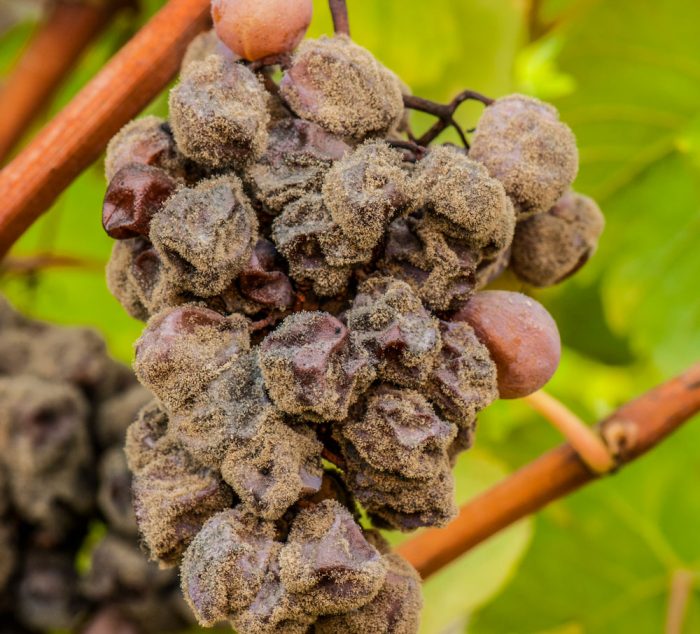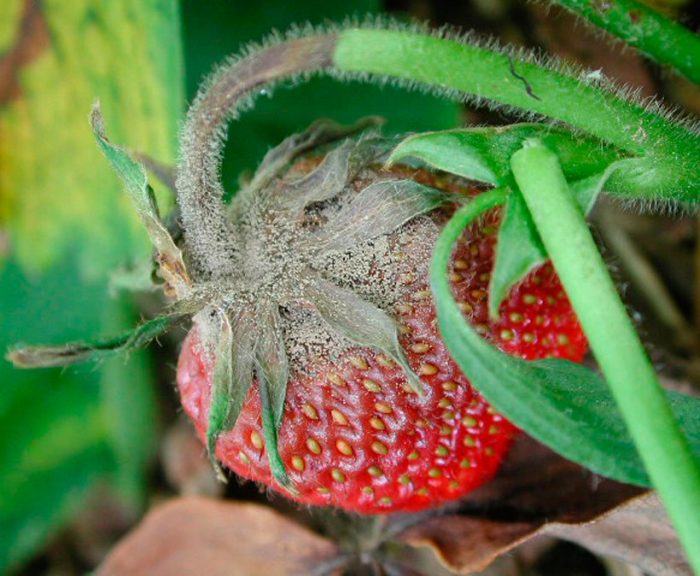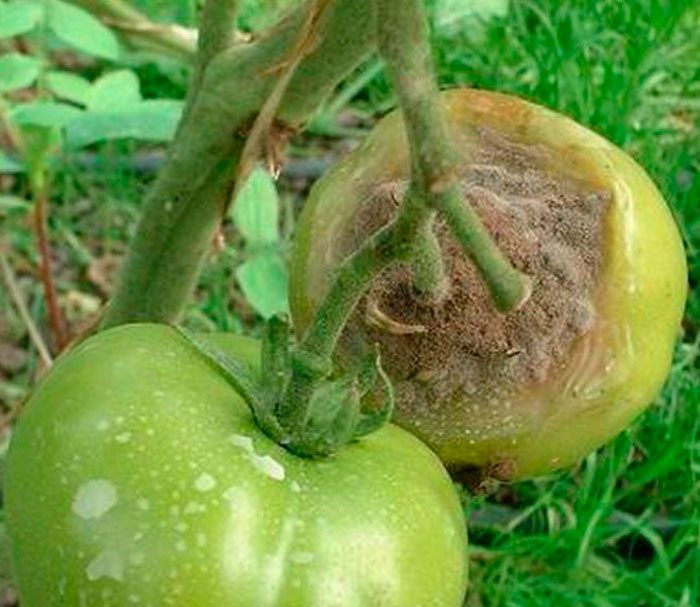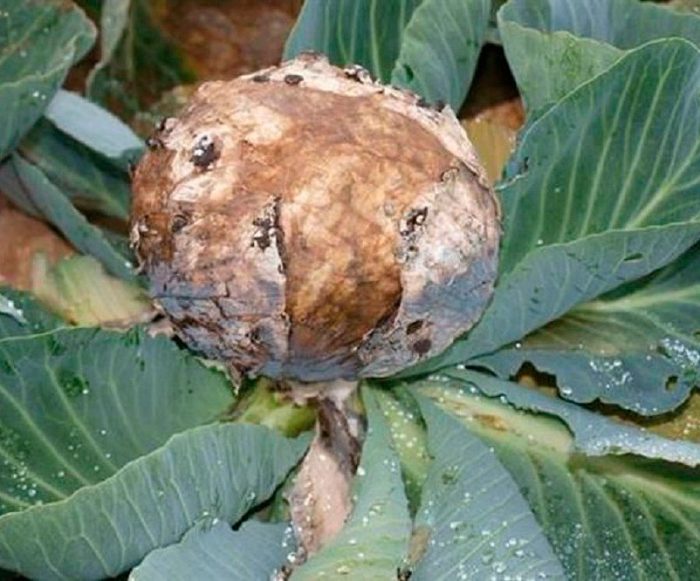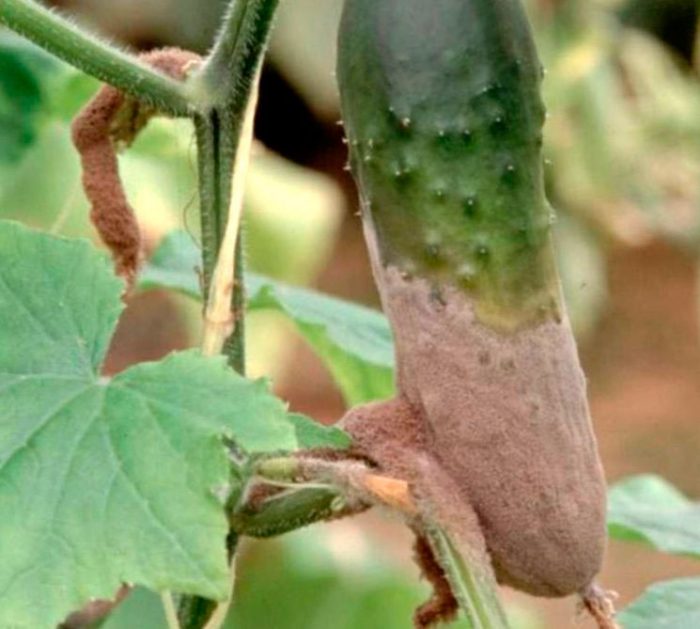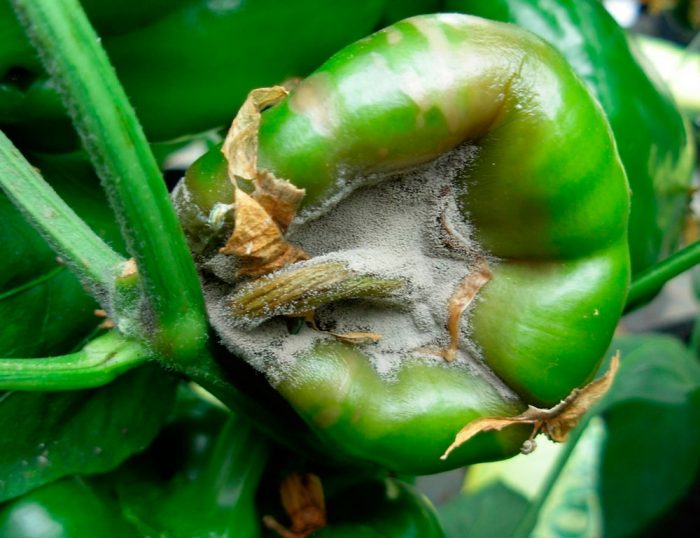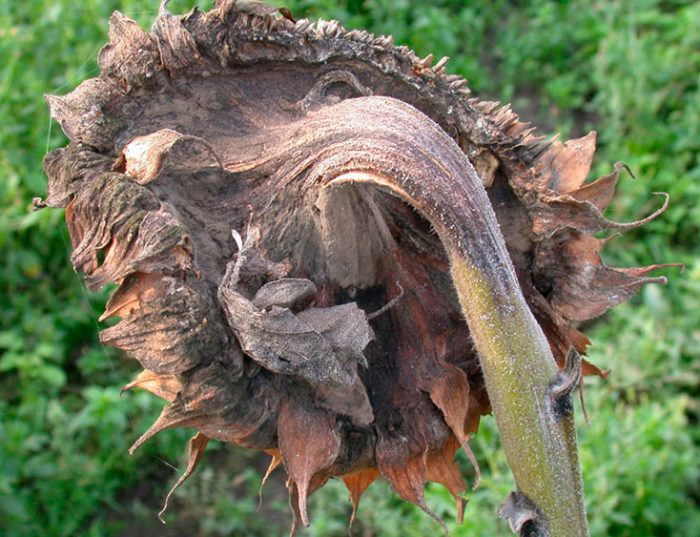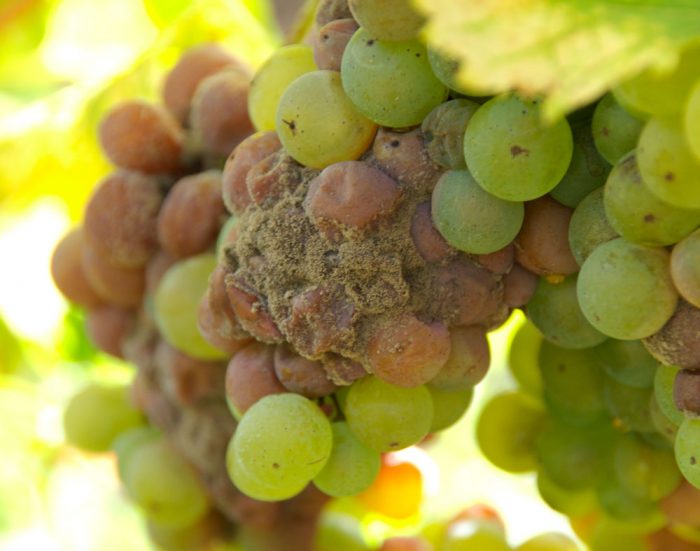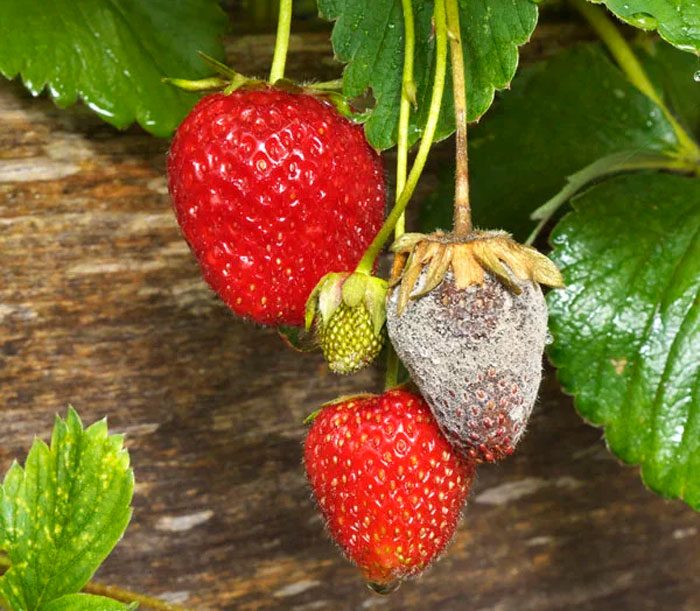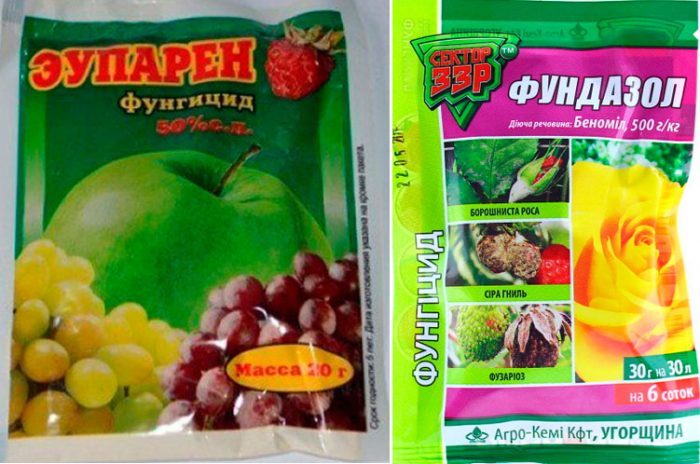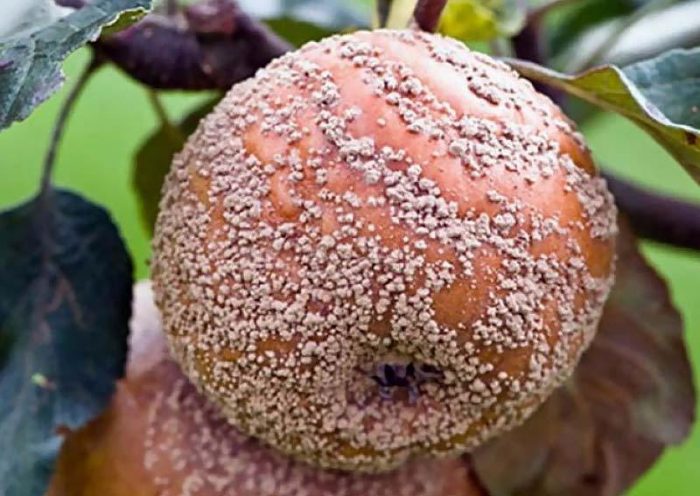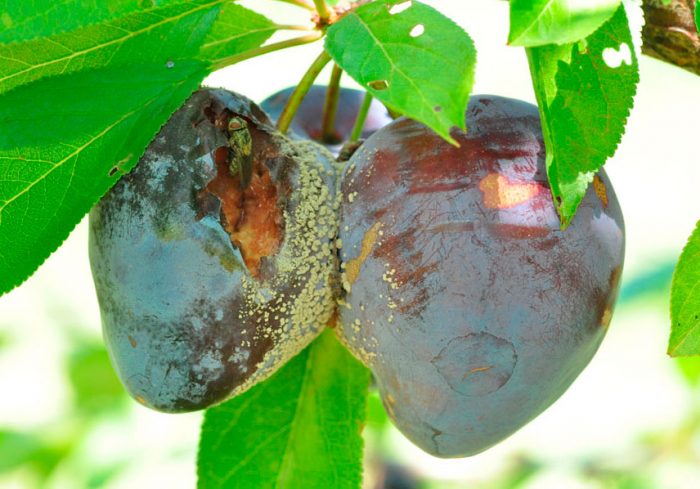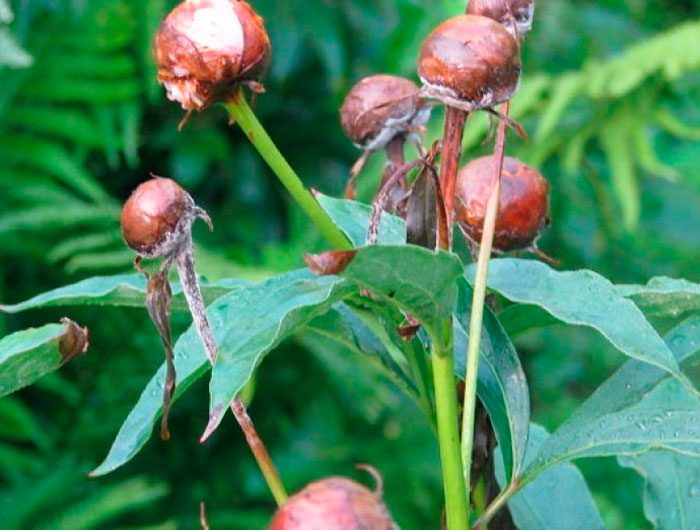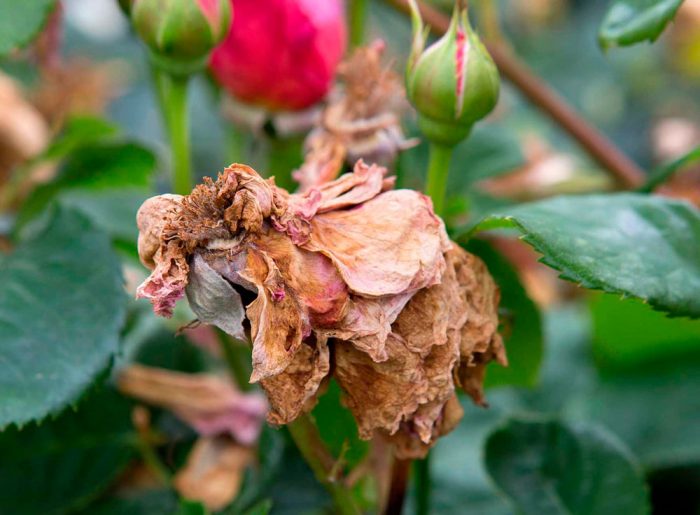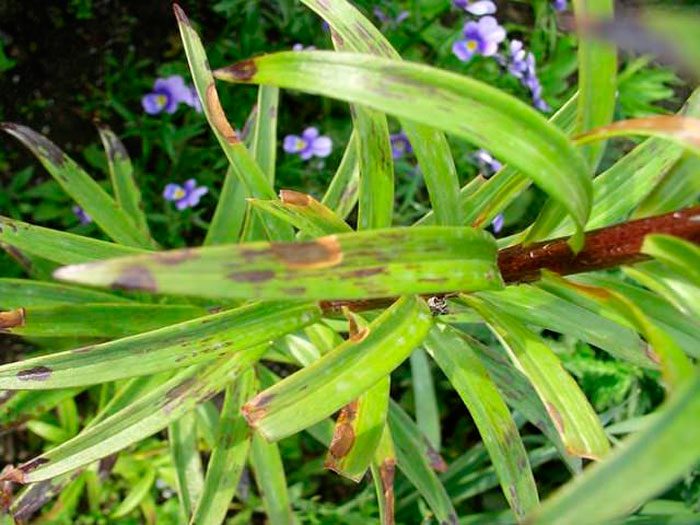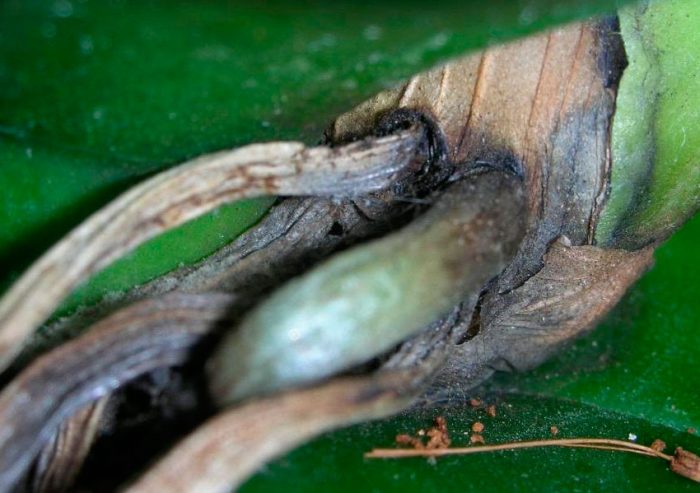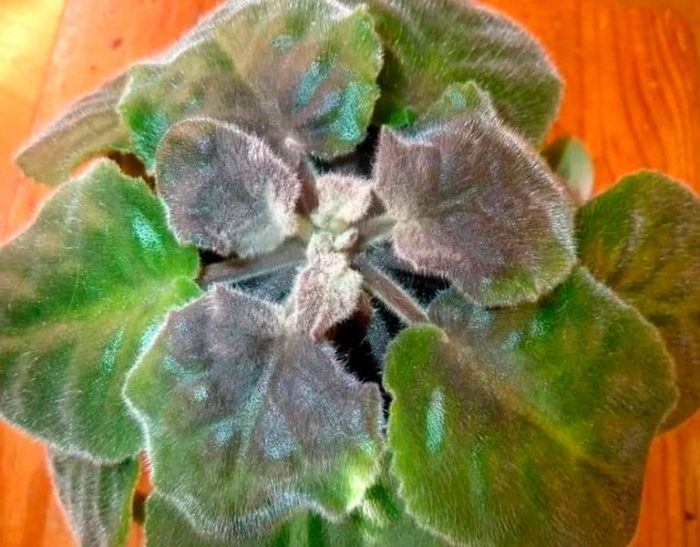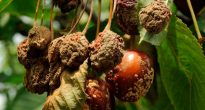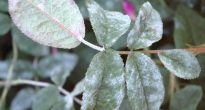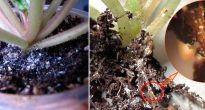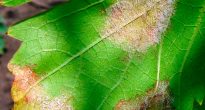Both wild and cultivated plants are affected by gray mold (Botrytis cinerea). It manifests itself during the transportation and storage of fruits. The causative agent of this disease is the fungus Botrytis, which is considered a wound parasite. Sources of infection are conidia and sclerotia, which are found in plant debris and soil. Most often, the disease begins to develop in protected ground under conditions of the presence of drip moisture on the dead parts of the plant. Shoots, flowers, foliage and fruits of those bushes that are strongly weakened are affected first.
Content
Features of gray rot
The causative agent of gray rot can be present on the site for a long time and feed on various organic residues, while the gardener or gardener may not even be aware of its presence. But when the air humidity becomes high, and at the same time the temperature drops, then the likelihood of contamination of crops with this disease will significantly increase. Only those berries, fruits and roots are affected, on the surface of which there is damage, if they are completely intact, then this disease is not terrible for them. Experts also call such a disease "a parasite of a warm corpse", since at first it settles on a dead area and only after that it captures living tissue.
The first signs of gray mold are spots on the surface of stems and foliage. The spots rapidly increase in size, and with high air humidity on the surface of these brown necrosis, a fluffy gray coating appears, which consists of spores and mycelium. After the disease reaches the fetus, first of all, the stalk is damaged, and then gray rot covers the entire fruit. The wind promotes the spread of spores that can settle on any plant, because gray mold is omnivorous.
Most often, this disease affects crops such as grapes, garden strawberries, buckwheat, cabbage, peonies and gladioli. The gray rot that root crops get sick with is called clump rot. This disease is especially dangerous during the vaccination period, since Botrytis affects both cuttings and the site of vaccination.
Methods for dealing with gray mold
When the gray rot has just hit the plant, it can still be cured quite easily. Previously, for this, the bushes were sprayed with soapy water, but it was noticed that even a very high concentration of alkali in the solution is not able to destroy the causative agent of this disease. They used to fight this disease quite effectively with means of the benzimidazole group, but after some strains of gray rot mutated, they were found to be resistant to these drugs, and these funds also contain substances useful for this disease.
Gray rot is effectively combated with a solution of Bordeaux mixture, but this tool has an extremely negative effect on the quality of the fruit. In this regard, treatment with such a preparation is recommended only in early spring or late autumn. And in general, experts advise that plants should be sprayed with fungicidal agents only as a last resort.
You can also fight this disease using biochemical methods. In this case, a preparation is used containing spores of glyocladeum, which is a hyperparasitic fungus that infects other fungi. But remember that there is no drug that can completely cure a plant that is sick with gray rot. Therefore, all methods of combating the disease refer to preventive measures, thanks to them healthy fruits will not be affected by the disease. All affected plants or diseased parts of the bush are removed from the site and destroyed by fire.
Prevention measures
To protect the plants from damage by gray mold, immediately before planting or sowing, both bulbs and seeds are treated with a fungicidal preparation made on the basis of sulfur. After the seedlings appear, they are sprayed 2 times with a break of 1–1.5 weeks with a solution of Bordeaux mixture (1%). The third time the bushes are sprayed only after the harvest has been harvested.
It is also very important to adhere to the rules of agricultural culture, and special attention should be paid to compliance with crop rotation. You also need to timely remove from the site and burn branches, fruits, stems and foliage. Also, do not forget to timely deal with various pests (for example, moths and caterpillars) that can injure the tissues of plants and fruits, and because of this, the culture becomes vulnerable to botrytis pathogens. And also, before proceeding with the laying of the crop for storage, they carry out the obligatory disinfection of the storage. In addition, make sure that during the growing season crops do not feel a lack of potassium and magnesium, as these minerals make them more resistant to diseases.
In order to prevent damage to crops by Botrytis, in the area where the pathogen of gray rot may be located, it is recommended to pre-plant plants that emit phytoncides, for example: calendula, nasturtium, marigolds or mustard. In autumn, the site is being digged, and these plants are buried in the ground. With the onset of spring, it will be possible to plant any crops on this site.
Gray rot on vegetable crops
Tomatoes
Very often those tomatoes that are grown in the greenhouse are affected by gray rot. All aerial parts of the bush are affected: foliage, inflorescences, fruits and shoots. Weeping brown spots are formed on the surface of the plant, covered with a fluffy bloom of gray. At the same time, brown or gray dry specks of an elongated shape appear on the lower leaf plates and areas of the shoots, over time, mucus forms on their surface, and they close in a ring on the stem. If conditions are ideal for the development of the disease, then both injured and absolutely whole fruits can be affected by it. To prevent the appearance of gray rot, the following preventive measures are recommended:
- for cultivation, it is recommended to choose hybrids that are highly resistant to Botrytis, for example: Pilgrim and Vasilievna;
- seeds are subjected to mandatory pre-sowing preparation, for this they are treated with a solution of a fungicide made on the basis of sulfur;
- maintain a low level of air humidity in the greenhouse;
- fruits and bushes are protected from mechanical damage, and a very sharp sterilized tool is used to trim the stems, foliage and stepsons, and it is carried out in dry weather.
After the first symptoms of disease damage are noticed on the bush, you need to smear them with a paste made on the basis of a fungicidal agent as soon as possible, for example: Bordeaux mixture, HOM, copper sulfate, etc. After pruning, clean the area of plant residues, so how they can contain pathogens.
In order to slow down the growth and development rate of Botrytis on tomato stems by 1.5-2 times, the bushes are sprayed with sodium humate during the growing season. For prophylactic spraying of tomato shoots, a Trichodermin suspension is used, since it has a long and rather powerful protective effect. This suspension is also used for spraying affected plants, on which there are weeping spots, but before processing, all diseased leaf plates must be torn off. The bushes are sprayed in the daytime, since by the evening they should be completely dry.
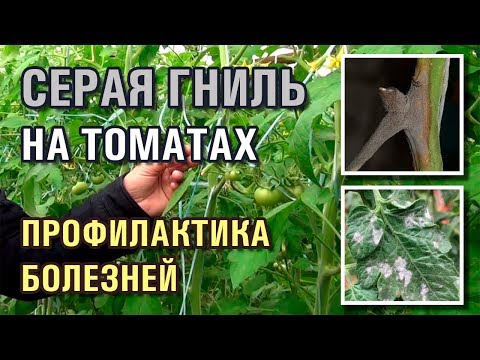

Watch this video on YouTube
Cabbage
Very often, gray rot affects cabbage, as well as other cruciferous crops. As a rule, the defeat of the disease occurs during prolonged rains at the end of the summer period or because of abundant growth. Botrytis develops even faster if the plants are frozen. Initially, the lower leaf plates are affected in the area of attachment of the petiole to the stump. Further, during storage, a gray coating appears on the surface of the head, and wet rot affects the foliage.
Botrytis develops extremely quickly, which makes it difficult to combat it. Therefore, it is very important to pay attention to preventive measures:
- remember the rules of crop rotation: four-field or five-field;
- for growing, choose those varieties of cabbage that are resistant to gray rot;
- for irrigation, use only well-settled water, which should be warm;
- make sure that the soil does not contain too much nitrogen;
- clean heads of cabbage in a timely manner;
- when the crop is harvested, the site must be cleared of all plant residues and cabbage stalks, which are then burned;
- when cleaning the heads for storage, make sure that there is no moisture on their surface (not a single drop);
- the optimal storage temperature for cabbage is 0–2 degrees, and the humidity level should be about 90%;
- before harvesting in storage, the room is thoroughly disinfected.
To get rid of botrytis on cabbage, you need to promptly remove all affected bushes or plant areas, which are then destroyed. If you already found signs of gray rot in the storage, it is recommended to install boxes in it, which are filled with quicklime, which will reduce the level of humidity. All diseased heads are removed away from healthy ones.
Gray rot on cucumbers
Botrytis can also infect cucumbers, and the pathogen penetrates the wounds. In some cases, the causative agent of the disease enters the flower through the pistil, which leads to the appearance of rot on the bud. Large shapeless spots appear on diseased leaf plates, on the surface of which there is a loose gray coating. The development of the disease can also occur in internodes, due to which those parts of the bush that are located above the site of infection die off.
In order to prevent the infection of cucumbers with this dangerous disease, one should not forget about the following preventive measures:
- grow only those hybrids and varieties that are resistant to disease;
- regularly inspect the bushes and remove the affected flowers and leaf plates;
- carry out systematic dusting of the affected parts of the cucumbers with the following mixture: 1 tsp. copper sulfate is mixed with 1 tbsp. wood ash and the same amount of chalk;
- systematically ventilate the greenhouse and make sure that the humidity level in it is optimal;
- temporarily suspend leaf-feeding cucumbers;
- remove plant residues from the garden in a timely manner and burn them;
- disinfect the substrate and seed material before sowing.
For prophylaxis, the bushes can, if desired, be treated with a Trichodermin suspension. In order to destroy the pathogen of gray rot in the greenhouse, a solution of Euparen multi (0.1%) is used for treatments, while the first spraying is carried out when 2 or 3 true leaf plates are formed in the seedlings. It is recommended to spray diseased stems of bushes grown in the open field with an aqueous solution of Rovral and chalk in a ratio of 1: 1 or 2: 1. In order for the agent to "stick" well to the sprayed surfaces, a little glue made on the basis of carboxymethyl cellulose (CMC) is also added to it. In the event that the disease develops rapidly, then the bushes are sprayed with a solution of copper oxychloride (for 1 liter of water, 4 g of the drug).


Watch this video on YouTube
Pepper
Indoor peppers can also attack gray mold. In this case, small specks of dark color are formed on the surface of fruits, shoots or flowers, which eventually grow, become weeping, and a gray coating forms on their surface. To save plants you need:
- improve ventilation in the greenhouse;
- timely tear off diseased foliage, flowers and fruits;
- clean the areas affected by Botrytis on the shoots and coat them with a thick suspension of the fungicidal preparation with chalk.
When planting seedlings, you need to maintain the distance between the bushes that is recommended by experts. Try to protect plants from mechanical or other damage. When the crop is harvested, clean the greenhouse from the tops and disinfect it, and also change the topsoil on the beds at least 50 mm thick.
Sunflower
All aboveground parts of sunflower can be affected by gray mold. In young bushes affected by the disease, the base of the stem turns yellow, then turns brown, and a gray coating appears on the surface, and the stem, which is located above, becomes faded and drooping. On the seamy surface of the basket, brownish-gray putrid specks appear, which may have a dirty red border. These spots increase in size, and an ash deposit forms on their surface. Seeds in a diseased basket become not viable, but even if sprouts appear from them, they will be colored dark brown, and rot is immediately present on them. This disease can kill up to half of the sunflower crop. In the fight against it, immediately after the first signs of gray rot are detected, the bushes are sprayed with a solution of the fungicide Pictor. When cultivating sunflower, it is necessary to adhere to such preventive measures as:
- remember the rules of crop rotation and grow sunflower in the same area where it grew this year only after 8-10 years;
- for sunflower, choose those areas where grain crops had previously grown;
- feeding the plant, try to add more phosphate and less nitrogen to the soil;
- before sowing, be sure to sort and process the seed;
- after harvesting, clean the area of plant residues and destroy them.
Gray rot on trees and shrubs
Gray rot of grapes
All aerial parts of grapes are affected by gray rot, but the greatest danger is botrytis on fruits. The disease develops and spreads most actively at high humidity and air temperature.When such favorable conditions are created, the development of the disease initially begins on damaged fruits, and then rot spreads to the entire brush. In botrytis spores, the incubation period is from 25 to 35 hours. If you touch the gray bloom, it will scatter dust, while the spores of the fungus will fall on nearby fruits and clusters.
To get rid of gray rot on grapes, you can use both folk and chemical remedies. For a person, of all means, the least danger is a solution of potassium iodide (2 grams per bucket of water). It is used only when the damage is localized. A solution of baking soda (8 grams per 1 liter of water) or copper sulfate (0.5 grams per 1 liter) is quite effective against botrytis. But remember that frequent spraying of this plant with copper sulfate is extremely undesirable, since the bluish bloom that appears after that on the leaf plates leads to a violation of their development. At the same time, spraying baking soda will not harm the plant, but this tool is not very effective. In the event that the bushes are very badly affected, and because of this, more than half of the crop may be lost, then spray them with a solution of such agents as: Fundazol, Topaz or Immunocytophyte.


Watch this video on YouTube
Gray rot of strawberry (garden strawberry)
When growing strawberries, remember that there have been years when, due to gray rot, gardeners have lost up to 80 percent of the harvest. That is why special attention should be paid to preventive measures. Main preventive measures:
- for growing garden strawberries, it is recommended to choose a ventilated and sunny area;
- before planting the bushes, the soil on the site must be prepared as recommended by experts;
- when planting seedlings, try to adhere to the scheme recommended by professionals, in this case your beds will not thicken;
- at the very beginning of the spring period, be sure to remove old foliage from the site, since it can cause strawberry bushes to become infected with gray rot;
- to protect strawberries from botrytis, they can be planted according to the following scheme: 4 bushes of garden strawberries and 1 bush of garlic or onions (such crops emit phytoncides);
- do not allow the soil to be excessively wet, and for this the plants should be watered regularly, but in moderation;
- do not add too much nitrogen to the soil;
- when the berries begin to ripen, it is recommended to reduce the dampness in the area, for this, its surface is covered with a layer of mulch (chopped straw) or covered with a dark film;
- when the stems begin to grow, the bushes are sprayed 2 or 3 times with an interval of 1.5 weeks with an iodine solution (1 ml of water for 1 liter of water).
If the plant is already sick, then you can try to cure it by alternately using mustard and garlic infusion. But if you want to win a complete victory over the disease, then you cannot do without special fungicidal preparations:
- Euparen multi... Plants are sprayed with them in the initial phase of flowering, and even during the mass flowering of garden strawberries.
- Fundazole solution (2%)... It is used for spraying during the period of peduncle extension.
- Alirin-B... Before the bushes bloom, they are sprayed 1 or 2 times, and at the end of flowering - 2 or 3 times. The break between treatments should be 1–1.5 weeks. To prepare a medicinal solution, 2 or 3 tablets are dissolved in one liter of water, and for preventive treatment, 1.5–2 tablets are taken for 1 liter of water.
- Switch... Spraying with such a tool is carried out before flowering and immediately, as the bushes will fade.


Watch this video on YouTube
Gray rot of raspberry
Since raspberries can be grown in the same place for 15 to 20 years, over time, the rhizomes of the bushes age, the stems become smaller, a decrease in yield is observed,and also plants become less resistant to disease. Also, the thickening of the planting, clogging and compaction of the soil on the site, as well as the neighborhood with strawberries (it is from her that raspberries are most often affected by gray rot) are also negatively reflected on the health of the raspberry plant.
Botrytis is capable of very much harm to raspberries. To destroy the infection, more than one spraying with pesticides will be needed, but all treatments must be carried out before the formation of fruits. In early spring, in order to get rid of the overwintered spores of the fungus, the bushes are sprayed with a solution of Bordeaux mixture (3%), and before the buds open, the plants and the surface of the soil on the site are sprayed with a solution of Nitrafen (2%). During the formation of buds and when the crop is harvested, the bushes are treated with a suspension of colloidal sulfur (10 grams of the product per 1 liter of water), instead of it, Tiovit Jet, Sumileks, Tsineb, Euparen, Albit or Bordeaux mixture can be used for spraying. If all the bushes on the site are affected by botrytis, then it is recommended to dig them all up and destroy, and then lay a new raspberry tree, but in a different place.


Watch this video on YouTube
Gray rot on the apple tree
The apple tree is also susceptible to damage by gray rot, in this case, the disease is also called fruit rot, or monilial burn, or moniliosis. The fact is that in this case, the causative agent of the disease is the Monilla mushroom, and not Botrytis. Initially, the disease affects the fruits, which is why they begin to deteriorate quickly. However, both fruits and flowers, ovaries, foliage and branches can suffer from moniliosis. They turn brown, then darken and die off. The greatest danger to an apple tree is a monilial bark burn: wounds and cracks appear on its surface, through which gum begins to flow, and large areas of wood under the bark, as well as overgrown branches, dry out.
The apple tree can be affected by moniliosis for the following reasons:
- there are damages on the bark, for example: scratches, frost holes, cracks and notches;
- pests injured the peel of the fruit;
- the tree has phytopathologies;
- healthy parts of the plant are in contact with those affected by moniliosis;
- the apple variety is easily affected by fruit rot.
Fog, rain, hail, dew, cold lingering spring, abnormally snowy winter, high temperature and humidity, strong wind can contribute to the disease of an apple tree with monilial burn. Also, the disease can develop if the plant was cut off or grafted with a non-disinfected tool or a dirty container was used to collect fruits, as well as when apples are stored for storage in a room that has not been previously disinfected.
In a diseased tree, the following signs of fruit rot can be found:
- there is browning or darkening of the flowers, which dry out over time;
- ovaries, foliage and fruit twigs become dark and charred, but they do not fly around;
- small brown specks form on the surface of the fruit, which increase over time;
- the flesh turns brown and becomes soft;
- a lot of white or gray mold pads appear on the affected apple;
- the fruit turns black or brown;
- there is an infection of apples and branches located nearby.
As soon as the first symptoms of fruit rot are found, all diseased parts of the apple tree should be cut out immediately and destroyed. Then several sprays of the tree are carried out with a special fungicidal preparation. Preventive measures:
- Carry out a systematic examination of the plant, this will help to timely detect the onset of the development of the disease.
- Protect the wood from mechanical damage, frost cracks and cracks.
- Be sure to treat the plant from pests in a timely manner, and moths, geese and sawflies are considered especially dangerous in this case.
- Harvest carefully, taking care not to injure the skin on the apples.
- Store fruit in clean, disinfected boxes.
- Before laying the crop, the storage is subject to mandatory disinfection. The optimum storage temperature is about 0 degrees.


Watch this video on YouTube
Plum and other fruit trees
Both apple trees and other stone fruit crops, such as cherry, cherry plum, peach, plum, sweet cherry and apricot, are affected by gray fruit rot or moniliosis. The greatest danger to fruit trees is a monilial burn of shoots, due to which inflorescences begin to die en masse. If the plant is very badly affected, it can lead to the death of the entire tree.
To protect the fruit tree from such a dangerous disease, do not forget about preventive measures:
- For cultivation, hybrids and varieties are chosen that are resistant to disease. For example: plum varieties - Hungarian Azhanskaya or Omashnyaya, Green Renklod; cherry variety - Anadolskaya; apricot variety - Red-cheeked; peach varieties - Juicy and Golden Jubilee.
- Cut off all diseased branches that have already dried up, immediately after flowering ends, or in autumn after the end of leaf fall.
- A systematic collection of diseased fruits and their destruction is carried out.
- In the fall, the aisles are plowed, and the soil is dug up in the near-trunk circles.
- At the beginning of the spring period, before the buds swell, and in the autumn, at the end of the leaf fall, after all the foliage has been removed from the site, the plant and the soil surface in the near-stem circle are sprayed with a solution of DNOC (1%) or Nitrafen (2-3 %).
- Trees are treated for prophylaxis with a solution of Bordeaux mixture or other means of a similar action (be sure to follow the instructions on the package) shortly before flowering, during the formation of ovaries, and then 30 days after the second treatment. At the same time, experts advise combining fungicidal preparations with chemical agents for weevils and moths.
Gray rot on flowers
Peonies
Gray mold can attack garden flowers such as peonies. In this case, early flowering varieties are most often affected. In the affected bushes, rot appears at the base of the shoots in spring. Then botrytis infects flowers and buds, as a result of which they first darken, and then a gray coating appears on their surface, after which they fly around. Further, in the middle of the summer period, large brown spots appear on the leaf plates and shoots, after which the root system of the bush is damaged, and it rots.
In order to prevent the defeat of peonies with botrytis, it is necessary to strictly observe all preventive measures and agrotechnical rules of culture. But if you do not have the desire to protect the flowers from this dangerous disease every year, then plant those varieties of peonies that are resistant to gray rot on the site. For planting them, choose sunny areas with nutritious soil that allows water to pass through well, and plant them as far as possible from the roots of trees and shrubs. Before planting, inspect the root system of the bushes and cut out all the rotten areas with a sharp pre-disinfected knife, sprinkle the cuts with chopped charcoal or anoint with brilliant green. It is also recommended, before planting, to hold the roots of peonies for 10-12 minutes in slightly hot water (from 60 to 70 degrees), after which they are dried and then planted, while 2 tbsp. Are poured into each hole. wood ash.
After the bushes finish blooming, they stop feeding them with nitrogen-containing fertilizers. In the spring and summer, be sure to cut off all injured parts of the bush, and in the fall, cut off all the stems. If you still fail to protect the peonies from botrytis, then spray them with a solution of Skor, Vectra or Maxim.
Gray rot on roses
Botrytis develops especially intensively on roses in winter under cover: on the upper parts of the shoots, depressed brown specks form and grow.The spots grow very quickly and cover the entire stem from top to bottom. After that, gray mold appears on the affected areas. If the ventilation is very poor, then the disease can affect the whole bush.
In summer, the disease manifests itself with sharp fluctuations in temperature against the background of heavy rainfall. Blurry spots appear on the affected leaf plates, on the surface of which a gray coating forms, which rapidly spreads to healthy flowers, stems and foliage located nearby. And on them light spots of a round shape already appear, which after a while turn brown, and a gray bloom of decay forms on their surface. This disease is most dangerous for grafted roses, since it causes damage to the root collar.
It is recommended to spray the affected bushes with a solution of one of the following drugs: Gamair, Euparen multi, Fundazol, Alirin-B or Fitosporin-M (follow the instructions on the package). The Benlata solution also effectively fights Botrytis on roses, and the bushes are treated with it regularly once every 4–5 days until all symptoms of the disease disappear on the roses. However, before you start processing, cut off all the diseased parts of the bush and try to create the most favorable conditions for the plant for its speedy recovery. In the future, it is necessary to systematically loosen the soil in the near-trunk circle, and also regularly fill it with a layer of mulch. To increase the resistance of roses to this dangerous disease, they are fed with manganese fertilizer, because it slows down the reproduction of pathogenic fungi.
Lilies
If cultivating lilies, you do not adhere to agricultural rules, then botrytis can strike them. Most often, the bushes are affected by the disease after cold precipitation, when the foliage does not have time to dry well until evening, or as a result of sudden changes in temperature during the day and night.
Bushes affected by gray rot have a significant slowdown in vegetation. OT and LA hybrids are the most resistant to this disease. In diseased plants, brown spots of a round shape with a dark red border are formed. They increase in size over time, and a gray coating forms on their surface.
In order to prevent the disease, the following measures must be adhered to:
- immediately before planting in the ground, the bulbs are etched in a solution prepared from Fundazol;
- change the area intended for growing lilies as often as possible, in this case, the pathogens of gray rot will not have time to accumulate in the soil;
- avoid thickening of the plantings and pour wood ash into each hole;
- you need to water the bushes in moderation, but they do it in the morning, and water should be poured at the root;
- in the spring, the bushes are prophylactically sprayed with a solution of copper sulfate (1%), after which they are treated a couple more times with the same agent with a break of 1–1.5 weeks;
- during prolonged rains, make sure that the lilies do not get too wet, for this they make a canopy over them from a greenhouse film.
Gray rot on indoor plants
Orchid
Since the appearance and development of gray rot is facilitated by dampness, coolness, and insufficient ventilation, indoor plants, for example: Cattleya or Phalaenopsis, can also get sick with it. Most often, this fungal disease affects those bushes that are already quite old. Initially, brown spots are formed on the surface of the plant, which gradually grow, and a pinkish border appears around them. With the active development of the disease, the spots begin to connect with each other, and a gray bloom appears on their surface.
When the first symptoms of the disease are detected, the plant must be immediately placed in the most favorable conditions for its growth and development.The fact is that fungicidal preparations can help prevent new outbreaks of the development of the disease, but they are not able to completely cure a flower from botrytis. Also try to understand what caused the onset of the disease, and then cut off all the dead parts of the bush, and also remove the loose leaves and flowers, which will reduce the spread of the disease. Place the bush in a room with good ventilation and make sure that the air humidity is not higher than that recommended by experts, and also provide the plant with an optimal temperature regime. Avoid getting water on the plant while watering.
Inspect nearby flowers, paying special attention to those that may be affected by Botrytis, for example: Saintpaulias, Fuchsias, Amaryllis, Camellias, Calla lilies, Castor oil plants, Lilies, Azaleas, begonias, cacti, ferns and Caladiums. Examine them for pests or signs of disease. If you bought an orchid recently, then for at least 15 days it is placed away from other flowers to check if it is affected by gray rot or other disease.


Watch this video on YouTube
Violets
Usambara violets are very cute and spectacular, so it is not surprising that often inexperienced growers take care of them overly actively, they water them too often and moisturize the foliage. Such care can lead to the development of botrytis, which causes brown specks and a fluffy gray coating to appear. When the first signs of a disease are detected, the bushes must be sprayed with a solution of a fungicidal preparation, for example, Teldor or Sumileks can be used. Also, be sure to stop wetting the violet from the sprayer and reduce the amount and frequency of watering. If the flower cannot be saved, then find a healthy leaf plate on it and try to root it.
Basic rules for caring for a violet for beginners:
- A flower that was bought recently is placed away from other plants, and for four weeks it is observed whether signs of disease or pests appear on it. If after a month no alarming symptoms were noticed, then move the bush to a permanent place.
- It is best to moisten the bushes with bottom watering. To do this, put water in a bowl and place a container with a flower in it so that the water does not overflow over the edge of the pot and does not fall on the substrate. Remove the pot from the basin only after the surface of the soil mixture begins to shine with moisture. After all the excess liquid has drained from the pot, it is put in its permanent place. Fresh water is used to water each plant, otherwise you can contribute to the spread of the disease. Bushes are watered once every 10-15 days.
Preparations for gray rot
Below will be described those fungicidal preparations that are used to combat gray mold most often:
- Teldor... This locally systemic agent with low toxicity is used in the fight against gray mold. To prepare a solution for processing grapes in 1 liter of water, dissolve 0.5 grams of the drug, and for spraying strawberries and peaches, take 0.8 grams per 1 liter of water.
- Sumileks... The drug is used for the prevention and treatment of botrytis, it is distinguished by contact and some systemic action.
- Fundazol... It is a systemic agent of a wide spectrum of action, plants are sprayed with it no more than 2 times during the season, otherwise the crops develop resistance. The product is dangerous for animals and people.
- Gamair... A biological bactericidal preparation used for both prevention and treatment of gray mold, it does not pose a danger to animals and people.
- Alirin-B... Biological agent against fungal diseases, which is similar in action to Fitosporin. Not dangerous for animals and people.
- Euparen multi... This broad-spectrum drug is very effective against botrytis. Differs in moderate toxicity.
- Fitosporin-M... Microbiological agent of contact action.For humans, it is low-toxic, but it poses a danger to plants and bees.
- Vectra... Contact-systemic drug for the prevention and treatment of fungal diseases.
- Speed... This systemic remedy has a long-term protective and therapeutic effect. To prepare a solution for 1 liter of water, 0.2 ml of the drug is taken.
- Maxim... Contact agent for processing planting and seed material. It is not dangerous to humans, but it does harm to fish.
- HOM (copper oxychloride)... Contact and systemic-local means, characterized by moderate danger to people.
- DNOC... A powerful broad-spectrum agent with herbicidal, fungicidal and insecticidal properties. Toxic to animals and people, flammable and explosive.
- Tsineb... Contact-systemic pesticide and fungicide hazardous to humans and animals.
- Tiovit Jet... A contact fungicide and acaricide of moderate hazard to animals and humans.
- Trichodermin... Such a biological agent is used for the treatment and prevention of various diseases, it is not toxic to animals and humans.
- Immunityphyte... It is a multipurpose stimulator of plant growth and development, as well as their immunity.
- Topaz... This systemic drug is used to suppress the primary infection. It is not toxic to birds and humans, but dangerous to fish.


Watch this video on YouTube
Folk remedies
If you are not a supporter of the use of chemicals in the fight against gray mold, then you can try to protect plants with folk remedies:
- Pour 100 grams of garlic husks into a bucket of warm (about 40 degrees) water. The infusion will be ready after a day.
- Half a bucket of hot water is combined with 50 grams of mustard powder. After 2 days, the infusion will be completely ready, it will remain to be diluted with water in a 1: 1 ratio.
- Pour 1 tsp into a bucket of water. copper sulfate and one glass of chalk and wood ash. This volume is enough for spraying 2-3 square meters of strawberries or cucumbers.
- For prevention purposes, an iodine solution is used. 10 liters of water are mixed with 10 drops of iodine. Such a solution is regularly used for spraying bushes, which is carried out 1 time in 7 days.
- Strawberries affected by gray rot and the soil on the site are treated with an ash solution (for 10 liters of water, 2 tablespoons of wood ash).
- Treat the bases of bushes and foliage of garden strawberries in order to prevent botrytis during the period of ovary formation with dry lime (for one plant from 15 to 20 grams).


Watch this video on YouTube

